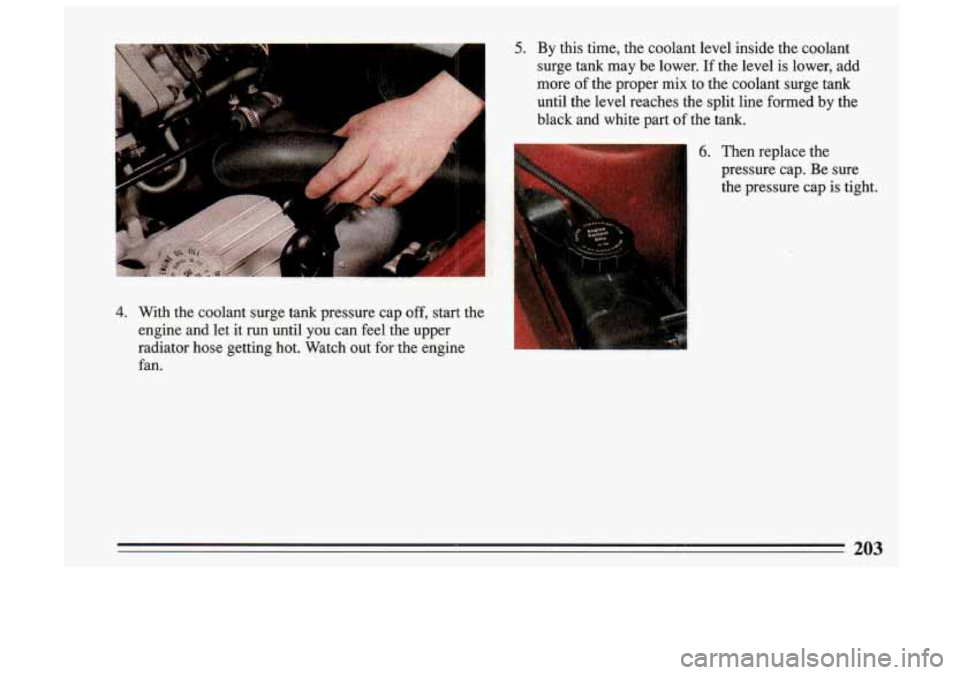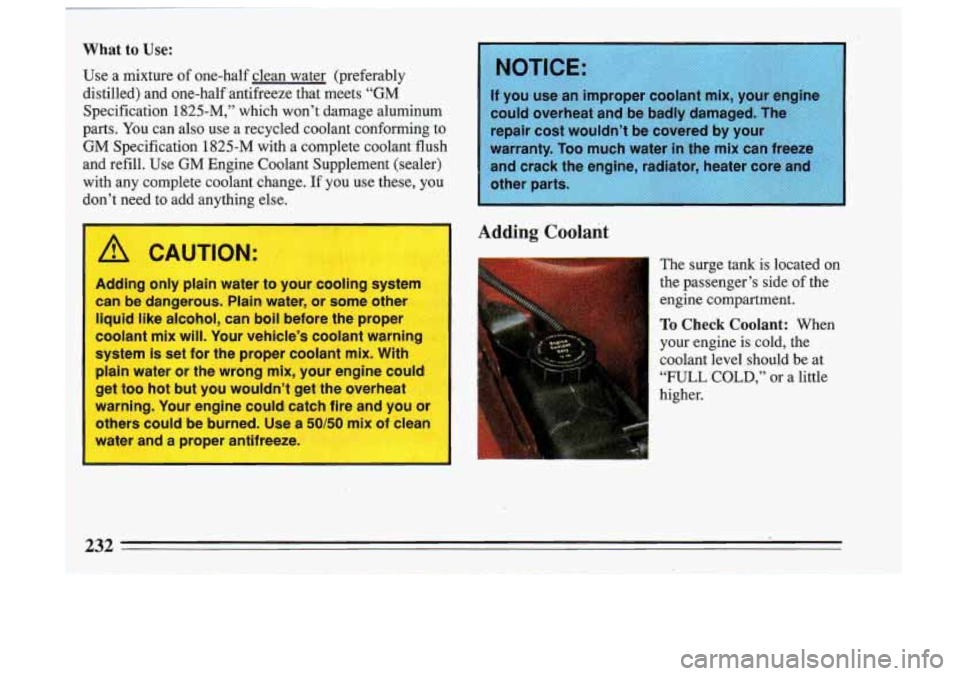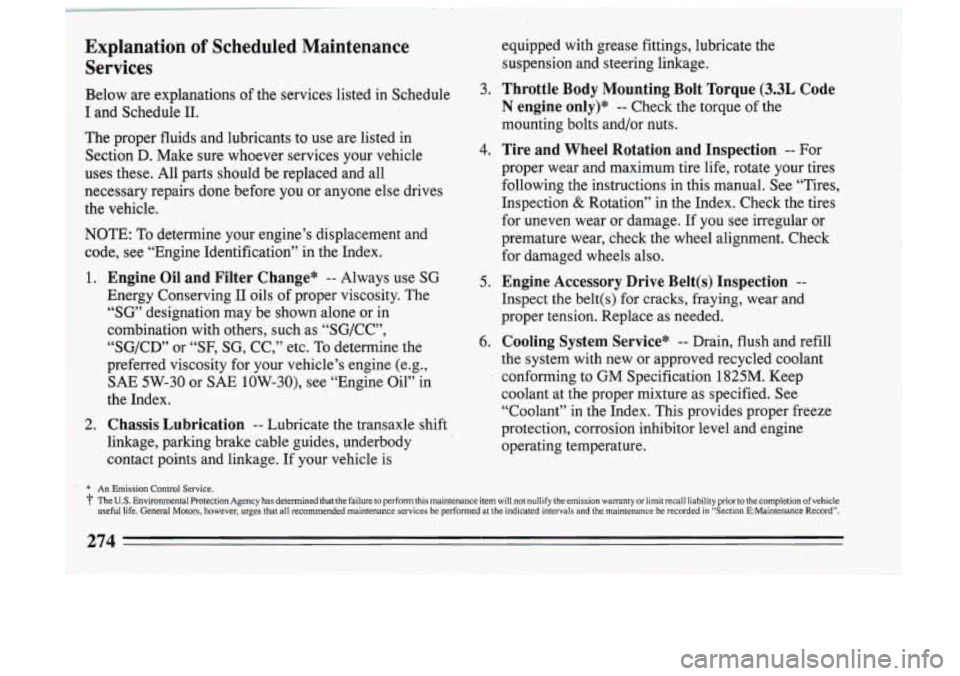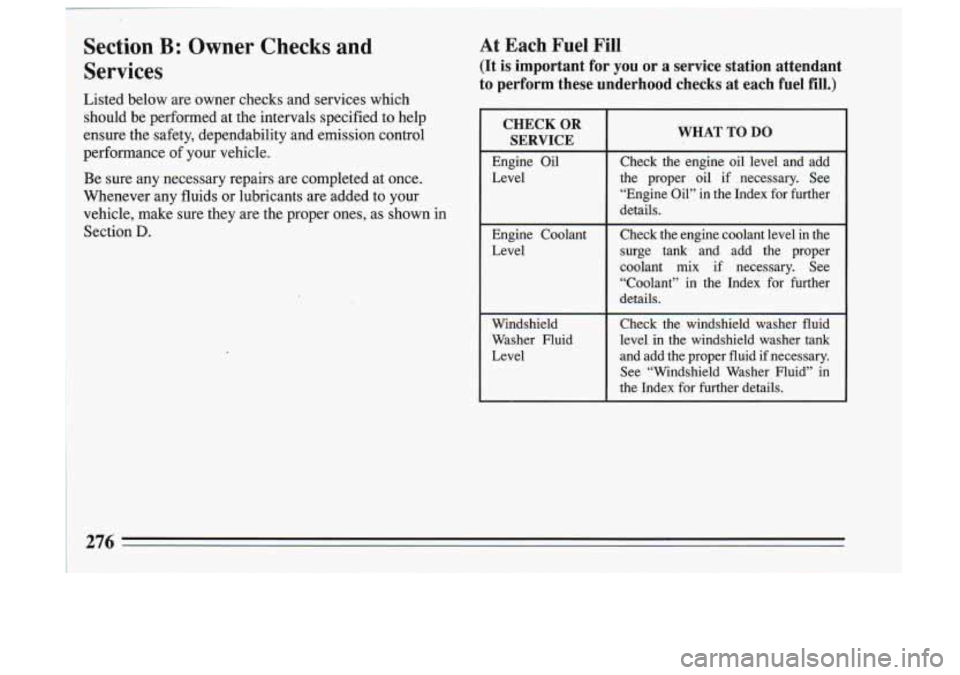1993 BUICK SKYLARK coolant level
[x] Cancel search: coolant levelPage 122 of 306

BIL (Bi-level) Windshield Defrost
This
setting allows the outside air to flow through your
Buick in two ways. Cooler air is directed to the upper
portion of your body through the vent outlets. Slightly
warmer air
is directed through the heater ducts and
defroster outlets.
Vent
Using vent will allow outside air to flow through the
instrument panel outlets. Set the temperature knob as
desired.
Heater
On days when it’s cold outside, this setting sends heated
air through the heater ducts and
the windshield defroster
outlets. If you have the engine block heater, you can use
it in cold weather (+2OoF/-8 OC or lower) to heat your
vehicle’s passenger area quicker. The engine block
heater warms the engine coolant which
will ultimately
warm the passenger area more efficiently.
( See “Engine
Block Heater” in the Index.)
Blend
This setting divides the air flow equally between the
heater and the defroster outlets. This setting operates the defroster. Most
of the air comes
out near the windshield. Use defrost when you get fog or
ice on the windshield.
Rear Window Defogger (Option)
The lines you see on the
rear window warm
the
glass. Press the button to
start warming your
.window. Pressing the
button again will shut it off.
If you
turn the rear defogger on while driving at or
above
45 mph (72 km/h), it will stay on as long as that
speed is maintained.
You must press the button to shut
it
off.
121
Page 200 of 306

A CAUTION:
I
An electric fan under the hood can start up even
when the engine is not running and can injure
you. Keep hands, clothing and tools away from
any underhood electric fan.
If the coolant inside the coolant surge tank is boiling,
don’t
do anything else until it cools down.
The coolant level should be at or above
“FULL COLD.”
If it isn’t, you may have a leak in the radiator hoses,
heater hoses, radiator, water pump or somewhere else in
the cooling system.
A CAUTION:
Heater and radiator hoses, and other engine
parts, can be very hot. Don’t touch them. If you
do, you can be burned.
Don’t run the engine if there is a leak. If you run
-le engine, it could lose all coolant. That could
cause an engine fire, and you could be burned.
Nt any leak fixed before you drive the vehicle.
If there seems to be no leak, check to see if the electric
engine fan is running.
If the engine is overheating, the
fan should be running.
If it isn’t, your vehicle needs
service.
199
Page 201 of 306

How to Add Coolant to the Coolant Surge
Tank
If you haven’t found a problem yet, but the coolant level
isn’t at or above
“FULL COLD,” add a 50/50 mixture of
clean water (preferably distilled) and the proper
antifreeze at the coolant surge tank, but be sure the
cooling system, including the coolant surge tank
pressure cap, is cool before you do it. (See “Engine
Coolant” in the Index for more information about the
proper coolant mix.)
/I CAUTION:
Steam and scalding liquids from a hot cooling
system
can blow out and burn you badly. They
are under pressure, and if you turn the coolant
surge tank pressure cap
-- even a little -- they can
come out
at high speed. Never turn the cap when
lhe cooling system, including the coolant surge
tank pressure cap, is hot. Wait for the coolin-
system and coolant surge tank pressure cap
13
cool if you ever have to turn the pressure cap.
t
Page 204 of 306

4.
5. By this time, the coolant level inside the coolant
surge tank may be lower. If the level is lower, add
more of the proper mix to the coolant surge tank
until the level reaches the split line formed by the
black and white part of the tank.
With the coolant surge tank pressur\e cap off, start the
engine and let it run until you can feel the upper
radiator hose getting hot. Watch out for the engine
6. Then replace the
pressure cap. Be sure
the pressure cap is tight.
fan.
203
Page 233 of 306

~~~x~~~~ of one-half clean water (preferably
distilled) and one-half antifreeze that meets
“GM
Specification 1825-M,” which won’t damage aluminum
parts. You can also use a recycled coolant conforming to
GM Specification 1825-M with a complete coolant-flush
and refill. Use
GM Engine Coolant Supplement (sealer)
with any complete coolant change. If you use these, you
don’t need to add anything else.
n
1 A CAUTION:
Adding only plain water to your cooling system
can be dangerous. Plain water, or some other
liquid like alcohol, can boil before the proper
coolant mix will. Your vehicle’s coolant warning
system is set for the proper coolant mix. With
plain water or the wrong mix, your engine could
get too hot but you wouldn’t get the overheat
warning. Your engine could catch fire and you or
others could be burned. Use a
50150 mix of clean
water and a proper antifreeze.
I
warrantv. Too much water in the mix can freeze
Adding Coolant
The surge tank is located on
the passenger’s side
of the
engine compartment.
To Check Coolant: When
.your engine is cold, the
coolant level should be at
“FULL COLD,” or a little
higher.
Page 275 of 306

Explanation of Scheduled Maintenance equipped with grease fittings, lubricate the
Services suspension and steering linkage.
Below are explanations
of the services listed in $chediie ‘ ‘ 3. Throttle Body Mounting; Bolt Torque (3.3L Code . , I:
I and Schedule 11.
The proper fluids and lubricants to use are listed in
Section
D. Make sure whoever services your vehicle
uses these. All parts should be replaced and all
necessary repairs done before you or anyone else drives
the vehicle.
NOTE:
To determine your engine’s displacement and
code, see “Engine 1dentific.ation” in the Index.
1. Engine Oil and Filter Change* -- Always use SG
Energy Conserving
I1 oils of proper viscosity. The
“SG, designation may be shown alone or in
combination with others, such as “SG/CC”,
“SG/CD” or “SF,
SG, CC,” etc. To determine the
preferred viscosity for your vehicle’s engine (e.g.,
SAE 5W-30 or SAE 10W-30), see “Engine Oil” in
the Index.
2. Chassis Lubrication -- Lubricate the transaxle shift
linkage, parking brake cable guides, underbody
contact points and linkage. If your vehicle is
An Emission Control Service.
N engine only)* -- Che& the torque of the
mounting bolts and/or nuts.
proper wear and maximum tire life, rotate your tires
following the instructions in this manual. See “Tires,
Inspection
& Rotation” in the Index, Check the tires
for uneven wear or damage. If you see irregular or
premature wear, check
the wheel alignment. Check
for damaged wheels also.
5. Engine Accessory Drive Belt@) Inspection --
Inspect the belt(s) for cracks, fraying, wear and
proper tension. Replace as needed.
6. Cooling System Service* -- Drain, flush and refill
the system with new or approved recycled coolant
conforming to GM Specification 1825M. Keep
coolant at the proper mixture as specified. See
“Coolant” in the Index. This provides proper freeze
protection, corrosion inhibitor level and engine operating temperature.
4. Tire and Wheel Rotation and Inspection -- For
The U.S. Environmental Protection Agency has determined that the failure to perform this maintenance item will not nullify the emission war\
ranty or limit recall liability prior to the completion of vehicle
useful life. General Motors, however, urges that all recommended maintenance services be performed at the indicated i\
ntervals and the maintenance be recorded in “Section EMaintenance Record”.
274
Page 277 of 306

Section €5: Owner Checks and
Services
I Listed below are owner checks and services which
should be performed at the intervals specified to help
ensure the safety, dependability and emission control
performance of your vehicle.
Be sure any necessary repairs are completed at once.
Whenever anv fluids or lubricants are added to vour
At Each Fuel Fill
(It is important for you or a service station attendant
to perform these underhood checks at each fuel
fill.)
CHECK OR
I SERVICE I WHAT TO DO
Engine Oil Check the engine oil level and add
Level the proper oil if necessary. See
“Engine
Oil“ in the Index for further .r .I
vehicle, make sure they are the proper ones, as shown in details.
Section D. Engine Coolant Check the engine coolant level in the
Level surge tank and add the proper
coolant mix
if necessary. See
“Coolant” in the Index for further
details.
Windshield Check the windshield washer fluid
Washer Fluid level in the windshield washer tank
Level and add the proper fluid
if necessary.
See “Windshield Washer Fluid” in
the Index for further details.